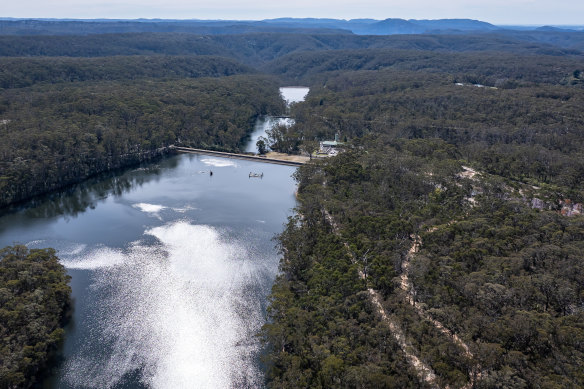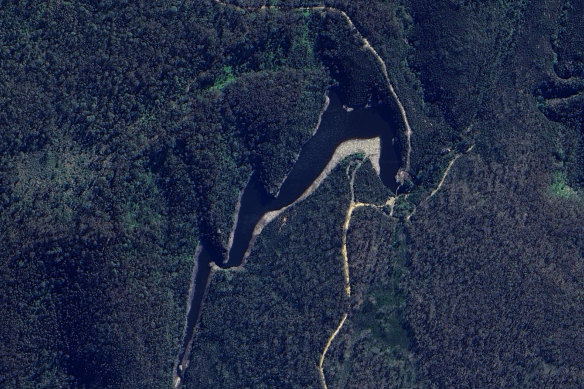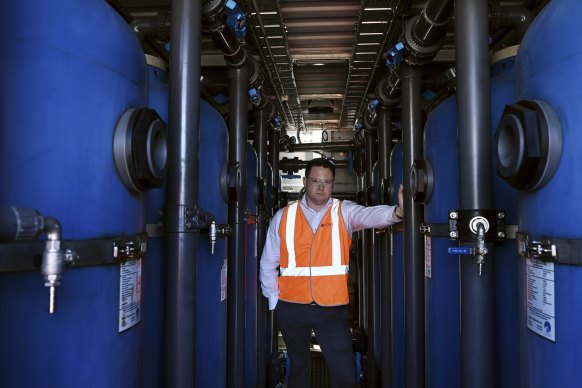Authorities have dramatically shut a dam in the Blue Mountains that has been identified as the source of “forever chemicals”, which have contaminated the water supply of 41,000 people in the world heritage-listed area.
The escalation comes after authorities were pressured into action after a Herald investigation in June which challenged the official position that routine monitoring of tap water was unnecessary because there were “no known PFAS hotspots in the catchment”.

The Cascade dams at Katoomba supply drinking water to about 41,000 residents. Credit: Wolter Peeters
After initially dismissing the Herald’s reporting, authorities quietly commissioned tests that reveal the true extent of contamination. WaterNSW revealed on Wednesday that the presence of the per- and polyfluoroalkyl substances (PFAS) in the Blue Mountains water supply had been traced to Medlow Dam, a remote water source off Beauchamp Road in Medlow Bath.
“This dam does not supply raw water directly, but as a precautionary measure has been disconnected from supply while further investigations are conducted,” a statement from WaterNSW on Wednesday said. The agency manages drinking water quality in the catchments.
Water from Medlow Dam is diluted by more pure water as it is fed into other dams that supply the Cascade water filtration plant.
“Sydney Water has confirmed the water supplied from the Cascade water filtration plant to local communities is safe to consume and meets the Australian drinking water guidelines,” the WaterNSW spokesperson said.
Authorities have been working since June to identify the source of elevated levels of forever chemicals in the Cascade water filtration plant, which supplies drinking water to residents as well as millions of tourists who descend on the region’s world-famous peaks.
The levels detected in the plant were within Australia’s drinking water guidelines but about quadruple what the US will allow its citizens to be exposed to after its dramatic policy shift in April found there was no safe level of the “probable carcinogens”.
They were also about 300 times higher than the levels in Warragamba Dam, Sydney’s main drinking water source.
New sampling results published on Wednesday show the source of the contaminants is probably high levels of PFAS in Medlow Dam. The readings exceeded both Australian and more stringent US safety standards.
Preliminary sampling has indicated Medlow Dam is the only dam in the network returning elevated readings, but WaterNSW said all dams would be subject to ongoing investigation and monitoring.
“WaterNSW will keep the community informed as the investigation progresses and work closely with NSW Health and Sydney Water to ensure drinking water remains safe,” the statement said.
The source of the contaminants in the Medlow Dam is unclear and experts have speculated at a link to the potential use of firefighting foam containing forever chemicals at the nearby Katoomba airfield.
A NSW EPA spokesman said the agency hadn’t been advised of any activities at the airfield involving the use of such foams or any investigations at the site.
The agency launched a statewide program in 2016 to determine the extent of forever chemicals pollution across NSW and identify significantly contaminated sites.

High levels of forever chemicals have been discovered in Lake Medlow. The water supply has been shut down. Credit: Google
Last week, it confirmed that there have not been any investigations at three fire stations which stored PFAS chemicals and are all within a two-kilometre radius of the Cascade water filtration plant.
The NSW Rural Fire Service said investigations would begin “in the near future” at its fire stations on Valley Road and Fitzgerald Street.
A third station belonging to Fire and Rescue NSW in the Katoomba CBD has been deemed low risk.
The NSW EPA oversees the investigations run by firefighting agencies.
“[Firefighting] sites are triaged and prioritised based on available information on the legacy use and storage of fire-fighting foams containing PFAS,” the EPA spokesman said. “Not all sites have used or have stored PFAS fire-fighting foams.”
The chemicals, which are prized for the stain-repellent and water-resistant properties and have delivered Wall Street giant 3M billions of dollars in profits over decades, have been used in hundreds of consumer products and never break down in the environment.
One of the forever chemicals detected in Medlow dam, perfluorooctanoic acid (PFOA), was recently declared carcinogenic by the World Health Organisation.
Two others, perfluorooctane sulfonate (PFOS) and perfluorohexanesulfonic acid (PFHxS) returned combined readings of between .0944 and .0946 micrograms per litre.
The Australian safe level for the two chemicals combined is .07 micrograms per litre.
The highest level detected in the Cascade water filtration plant which supplies tap water has been .0338 micrograms per litre.
It comes as a leading remediation expert said he was unsurprised that PFAS had made its way into Australians’ drinking water supplies, given how frequently it is found during construction projects.

Sean Halpin at a site in Seven Hills belonging to his remediation firm SciDev. Credit: Kate Geraghty
“If they test for it, it’s reasonably likely it will be there,” said Sean Halpin, the chief executive of remediation firm SciDev.
Halpin said a source of confusion for private industry was why they had to pay to clean up water discharged into the environment to a level up to 304 times stricter than what is permitted in Australia’s drinking water.
“What they [clients] have to treat and discharge, versus what’s coming out of the taps in the lunchroom, are two different things,” he said.
A Department of Health spokesman said there were different methods for developing safety guidelines for drinking water and environmental water, depending on the specific sensitivities of the organisms they are protecting.
“PFAS exposure may be more harmful to other animals compared with humans,” the spokesman said, noting animals living in water often had a smaller body mass, underwent life cycle changes in the water and could be exposed to chemicals 24 hours a day.
Halpin said the inconsistencies in the health advice between countries was also causing anxiety for the public and affected industries.
The Australian government’s official website states: “There is also limited to no evidence of human disease or other clinically significant harm resulting from PFAS exposure at this time.”
In contrast, links to adverse health effects are recognised by the World Health Organisation, United States, Canada, Europe and the UK.
“It’s difficult to reconcile,” Halpin said. “I think people are crying out for an answer.”
A Department of Health spokesman said it acknowledged exposure to some PFAS had been associated with biological effects on the kidneys and hormone levels, and mildly elevated levels of cholesterol.
“It is not unusual for guidance values to vary from country to country depending on the local context, the methodologies and assumptions used, the choice of endpoints used and expression of units,” he said.
The spokesman said a current review of Australia’s drinking water guidelines for PFAS would consider recent guidance from international jurisdictions to determine whether they are suitable to adopt or adapt for the Australian context.
Start the day with a summary of the day’s most important and interesting stories, analysis and insights. Sign up for our Morning Edition newsletter.